Hockey drills
- A passes the ball to B
- B passes the ball back to A
- B runs wide and gets a hard targeted pass from A
- B receives the ball, aligns the ball and finishes on goal
- Then he runs towards the goal and gets a hard ball from C
- B causes the ball to change direction by a tip-in
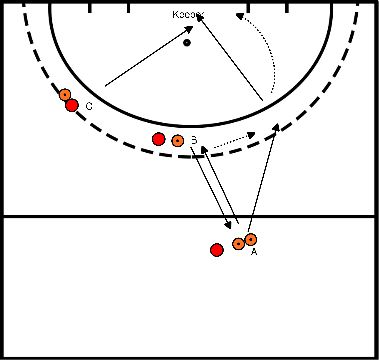
- A starts with the ball and makes eye contact with B
- B moves on and indicates where he wants the ball and receives the ball from A
- He completes his turn and makes eye contact with C
- C starts running and gets the ball from B
- C runs into the circle and shoots at goal
- Execute exercise on the other side as well

- A starts with the ball and plays the ball to B (defender must not intercept)
- B then has to play the ball back to A (defender may intercept this ball)
- When A has the ball again he plays it back to C
- C takes the ball and plays a 2 against 1 together with A who has ran through
- Tips for attackers:
- Keep speed in your game
- Play over backhand side of opponent
- See where your fellow player is standing
- Tips for Defenders
- Push them to the side
- Close the pass line between the attackers.
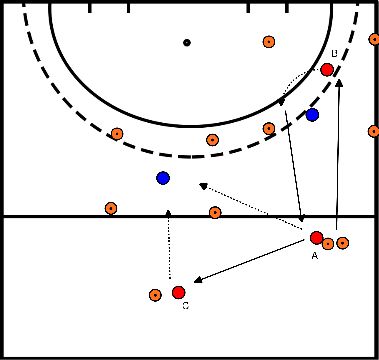
- A stands in the box with her back facing towards the back line
- B calls a colour either Blue or Orange
- A runs first to the front pilon and taps the pilon. She then runs to the other same coloured pilon and runs around it.
- B runs a bit with the ball and gives a straight ball to A
- A controls the ball while running and takes the ball to the circle and lines up and shoots.
- The same on the other side
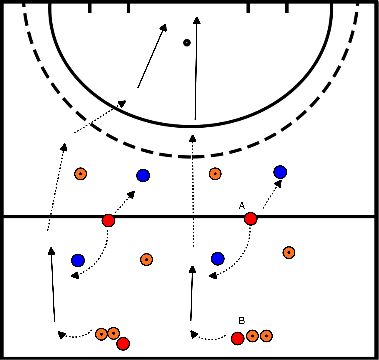
series of exercises to train postural muscles
- hip crossover
- scorpion
- one-hundred
- left hand on right knee, right hand on right ankle, stretched left leg (15 cm off the ground), shoulders off the ground -> alternate: right hand on left knee, left hand on left ankle, stretched right leg. Slow movement!
- On hands/knees (shoulders - trunk - legs rectangle). Right leg and right arm open towards ceiling, hips on top of each other. Turning back from here, dogpose, swing left leg up, back to hands/knees. Repeat! Ditto left.
- Lateral posture, upper leg stretched back, upper arm stretched forward. Bring hand to knee and extend again. Repeat! Same other side.
- Sitting on right hip, right hand on ground. From here up with left leg stretched towards ceiling and back again. Repeat! Same left.
- board position. From there, put foot for foot next to your hand and back again. Sequence: first right first, then left first (turn around).
- Everybody's got a ball, you're facing each other on the 23-metre line.
- Left and right is a line of pilons.
- The ball is light under your legs, at some point the trainer tells you how to stand (on your left leg, or touch your ankles) then the trainer calls left or right and you have to run to that side as quickly as possible and the ball must lie still on the line with pilons,
- If the ball is still on the line, run back to the 23-metre line as quickly as possible.
- Whoever is first wins.
- The pilons are about 3 or 4 metres from the 23 metre line, on both sides.
- You're facing each other with the ball in the middle,
- the trainer calls head, shoulder, hip, knee and toe as many times as you like and then, at some point, takes the ball and then the players have to take a ball as quickly as possible too.
- Only 1 can win.
Place 15 to 20 pylons over a distance of about 40 metres from the rear line towards the middle line, in a straight line. The spacing between them at the basic form is 2 meters.
Make 2 rows that are positioned behind the back line. The players do their exercise on both sides of the pylons at the same time towards the end of the series of pylons. There they turn and dribble with a wide curve back to the beginning. When the first two are at the fourth pylon, the next two can start.
Put players with an equal physical capacity next to each other. You can do a positional approach (defender versus defender, attacker versus attacker).
Exercise
1. On the signal the front 2 players start.
2. Sprint each time 2 pylons forward and then 1 pylon backward.
3. Keep your face forward, so don't turn during the exercise.
4. The intensity is 90% of the maximum capacity. Especially the forward runs (starting away) must be explosive and with short steps.
5. At the end of the series of pylons you turn with a wide bend and dribble easily back to the starting point.
6. Repeat this exercise once.
Variations
1. Identical to the basic form, but now with the pylons in a different pattern: between the first 2 pylons is 1 meter, between the next 2 meters, then 3 meters, 4 meters and finally 5 meters. After this you go down again (respectively 4, 3, 2 and 1 meter space between the pylons). In total you will have 18 pylons.
2. Identical to the basic form, but now with a different pattern: between the first 3 pylons 1 meter, the next 2 pylons 5 meter, then again 3 pylons with 1 meter, 2 pylons with 5 meter. After this, place the same pattern again (4 times the same pattern in 1 line, with a total of 18 pylons).
3. Identical to variation 3, but now you don't place the pylons in a straight line, but in curves.
4. You make a straight line of pylons and arrange them as you see fit. Make sure there is a lot of variation.
5. Identical to variation 4, but now with faint curves.
Intensity of the exercise
The intensity is 90% of the maximum effort. Panting, should be motivated execution with highly explosive character in the runs with a maintained body control and athletic posture, EMI 7/8.
The player with the red pilon is ready for the long corner. This player plays the ball to the left and gives the ball to the player coming from the white pilon. The player of the white pilon plays the ball as hard as possible into the circle (towards the goal).
When the long corner is taken, the players try to run into the blue and orange pilon and intercept the ball. The player who intercepts the ball scores on the back line and the other player scores on the 23-m line. It becomes a 1 to 1.
Swap: Red - White - Blue - Orange - Red
Attention: The player who takes the long corner stands ready as if he himself is going towards the circle. Pass the ball hard and low towards the dot.
- Put out the columns as shown in the figure
- Spread the balls over pylon C and D.
- In this exercise you place a player at pylon C and D.
- The rest of the team will line up at pylon A.
- From A onwards, the player walks around the pylon
- From the post, the player makes a sideways movement facing the ball (facing C).
- Player C plays the ball in the forehand of A
- A takes the ball and turns right open
- A runs in the direction of the circle and finishes at goal.
- From here he runs to D and receives another ball.
- The player turns open to the left and finishes on goal again.
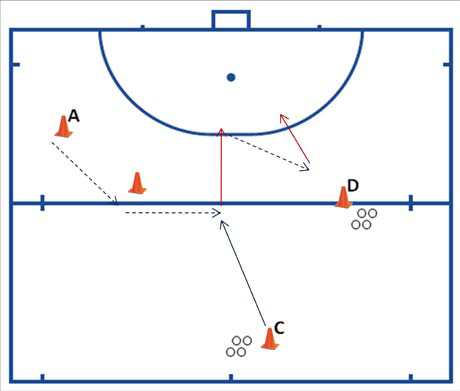

- Make groups of 2.
- No. 1 must try to hit the ball of
- no. 2, staying in a designated area. How often does No. 1 succeed? After some time, switch around and No. 2 may try to hit the ball of No.1.
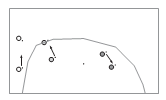
- The tagger should try to tap as many children as possible.
- If you are in danger of getting tapped you can call a television show and then the tagger is not allowed to tap you.
- You have to stand with your legs wide.
- The rest can be relieved by crawling between your legs.
- When you are tapped, you stand by the trainer.








